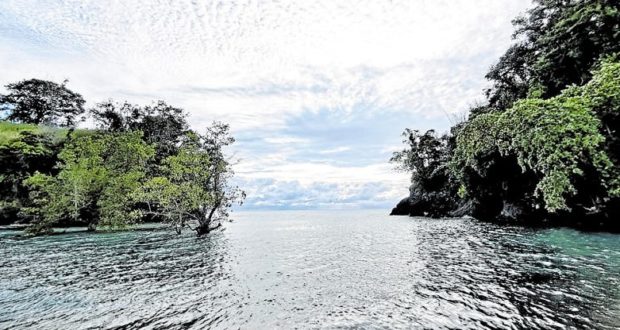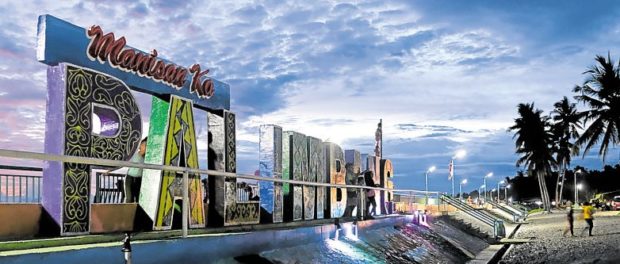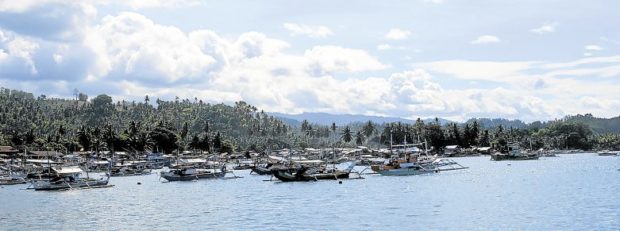Palimbang: Sultan Kudarat town bounces back from its bloody past

Visitors also flock to Medol Islet (banner photo), a perfect spot for swimming and hook-and-line fishing. —PHOTOS BY BONG S. SARMIENTO
PALIMBANG, Sultan Kudarat, Philippines — At the newly constructed baywalk of this predominantly Moro-populated town, a sign containing the Maguindanao phrase “Manisan ka Palimbang” welcomes visitors.
Palimbang is beautiful; that’s what it means.
True enough, a burst of colors on the horizon as the sun sets is a regular treat. At the 259-meter baywalk, the picturesque blue waters of the Celebes Sea is a sight to behold.
These majestic scenes belie a ghastly past that has haunted the town, and even Mindanao, for more than four decades.
On Sept. 24, 1974, some 1,500 male Muslim residents of Malisbong village—some as young as 10 and as old as 70 — were massacred inside a mosque by government troops.
Article continues after this advertisementThe children and women were rounded up and herded to a ship. Many of the women suffered torture and rape at the hands of soldiers.
Article continues after this advertisementThe village was a stronghold of the Moro National Liberation Front, which waged a secessionist rebellion in 1972. The massacre would galvanize support for the Moro resistance from sympathetic Muslims in other parts of the world.

PERFECT SPOTS The twin islands of Palimbang, Sultan Kudarat, are a stone’s throw away from Maganao Beach Resort and are easily accessible during low tide.
Clan wars
For decades, the second-class municipality (average annual income: P45 million to P55 million) established in 1959 near the western edge of Sarangani province, with a population of at least 94,000 today, was also notorious for “rido,” or deadly clan wars, that pit rival families, even blood relatives, prompting constant evacuations.
These are the reasons that the town’s beauty has remained hidden to outsiders for decades.
But things changed two years ago, as rido among large families were settled, bringing a radical improvement in the town’s peace and order situation, and stirring business growth founded mainly on tourism.
“Before, when 5 p.m. strikes, you will seldom see people in the streets due to the fear sown by lawless elements,” Mayor Joenime Kapina told the Inquirer.
But now, the well-lighted baywalk that was opened to the public recently has become a magnet that is drawing locals outside of their homes even at night simply to laze around and enjoy the sea breeze.
To add to the lively atmosphere, the local government indefinitely allowed carnival rides and food stalls to operate just across the baywalk.

SUNSET VIEWING BY THE BAY The newly constructed baywalk in the village of Baranayan in Palimbang has become a popular evening promenade among locals. Just along the national highway, the baywalk is a good vantage point for sunset viewing.
Tourism boom
Local tourists have been coming into the town through word of mouth.
“Our place is generally safe and peaceful now. That’s a big leap from before when our place is feared due to lawlessness and chaos,” Kapina said.
In Malisbong, a Moro heritage-inspired landmark archway welcomes tourists. Less than a kilometer away from the site of the 1974 massacre, a restaurant offering halal food and a relaxing view of the Celebes Sea is thriving.
Essentially, tourists visit this town to frolic on its still relatively unspoiled beaches and the natural islands that are close to the shorelines.
About 30 minutes away north from the town center is Medol Islet Beach in Barangay Medol. With the islet looming big from the shoreline, tourists can enjoy the sand, sea and sun at dirt-cheap rates.
Entrance fee is only P10. The open cottage costs just P200 while a floating cottage is rented out for only P500 per day. For an overnight stay, there are a few A-shape closed cottages made of light materials that can accommodate a family of four and rented for P500 each.
At Medol beach, one can hop to the islet with bancas (motorized outriggers) in less than five minutes for P20 per person, and enjoy its sandy white shorelines, swim at its turquoise waters, or go hook-and-line fishing.
Nearby Maganao Beach Resort boasts of its twin islands that are just a stone’s throw from the shorelines where one can trek toward the peak and enjoy the fascinating view of the vast Celebes Sea.
Maganao Beach is still pristine, save for the few open cottages that visitors can rent for P200 a day. There are spartan toilets and bathrooms with supply of fresh water.
Abdul Kadil Masil, the resort manager, said they were developing the resort to be affordable for the ordinary people.For now, pitching a tent for an overnight stay is highly recommended to protect visitors from the elements.

CHRISTIAN COMMUNITY The fishing village of Milbuk is home to Palimbang’s Christian population.
Peaceful
“Our place is peaceful and safer compared to decades ago because the feuding families have reconciled,” Masil told the Inquirer.
About an hour away from the shorelines by pump boat, the Balasan Sandbar beckons. Corals and fish of different varieties and sizes thrive in the area.
The sandbar is best accessed from the fishing village of Milbuk, which is located south of the town center and mostly populated by Christians. An outrigger that can carry 20 people can be rented for as low as P2,000, depending on one’s bargaining skills, to go to the sandbar.
Beside the beaches, the town has another natural treasure—the Sampaw B’leg waterfalls in Barangay Namat. It takes 45 minutes on a “habal-habal” (motorcycle) to reach the village and another one hour of an uphill climb to get to the falls.
In visiting the town’s swimming attractions, it is better for tourists to prepare their own food, as even small eateries are hard to find in these places.
Palimbang is three hours away from General Santos City. Public utility vans ply the route daily at P500 per passenger.
Joanne Zoe Egonia, Palimbang acting tourism officer, said they were anticipating more tourist arrivals in the years ahead hence they were already working on strategies to prevent the town from being overwhelmed by visitors.
“We are still mapping our other natural tourism spots,” she said.
With the growing local tourist arrivals, the municipal government constructed the two-story Palimbang Green Palace that can accommodate 40 people at a given time.
For business travelers, EJ Transient House offers a homey Filipino atmosphere with its “bahay kubo” (nipa hut) quarters neatly arranged in a garden.